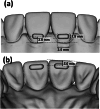Influence of Different Preactivation Patterns and Aligner Materials on the Capability of Aligners to Induce Palatal Root Torque of Upper Incisors: An In Vitro Biomechanical Study
- PMID: 40318158
- PMCID: PMC12418063
- DOI: 10.1111/ocr.12940
Influence of Different Preactivation Patterns and Aligner Materials on the Capability of Aligners to Induce Palatal Root Torque of Upper Incisors: An In Vitro Biomechanical Study
Abstract
Objectives: Previous studies have demonstrated that aligners with labial-cervical pressure points can induce root movement, but with initial unwanted tipping. This study assessed the impact of palatal-incisal pressure points on improving root movement and reducing initial offset. Additionally, the influence of aligner materials on force and moment generation was evaluated.
Material and methods: The experimental setup consisted of an acrylic upper jaw model with teeth 11 and 21 separated and secured to a Hexapod using a 3D force-moment sensor, allowing for the simulation of various malpositions of the measurement teeth. In addition to labial pressure points set close to the cervical margins at a depth of 1.5 mm, we investigated palatal pressure points positioned close to the incisal edge at depths ranging from 0.1 to 0.9 mm. We evaluated the force/moment (F/M) systems generated by both mono- and multi-layered aligner materials during the simulated correction of 2° retroinclination of the measurement teeth. Five aligners were tested for each configuration. The relevant palatal torque range (palTR) was identified when the aligners simultaneously induced a negative palatal force (-Fy) and a negative palatal torque moment (-Mx).
Results: PET-G aligners without pressure points showed no effective torque range. In contrast, aligners with pressure points generated an effective torque range of an average of 1.02° ± 0.03° following initial tooth tipping. The palatal-incisal pressure points showed a significant reduction or elimination of the initial offset. Our findings revealed a general correlation between palTR-start displacement (initial offset range) and palatal pressure point depth (linear mixed-effects models, p < 0.05). In this manner, the initial offset for the 0.6 mm pressure points was reduced by 81.1% compared to that of the unmodified aligners (from 1.57° to 0.3°).
Conclusion: The addition of palatal-incisal pressure points alongside labial-cervical pressure points demonstrated a promising reduction in the initial offset range in an in vitro setting, potentially enhancing the efficiency of torque movement with aligners. However, further biomechanical and clinical studies are necessary for the clinical translation of these results.
Keywords: aligner; bodily movement; force; modification; moment; root torque.
© 2025 The Author(s). Orthodontics & Craniofacial Research published by John Wiley & Sons Ltd.
Conflict of interest statement
The authors declare no conflicts of interest.
Figures





Similar articles
-
Upper incisal torque movement with clear aligners: A three‑dimensional finite element analysis.J World Fed Orthod. 2025 Aug;14(4):227-234. doi: 10.1016/j.ejwf.2025.04.002. Epub 2025 May 28. J World Fed Orthod. 2025. PMID: 40442002
-
Forces and moments on a maxillary lateral incisor using 3D-printed aligners with pressure points: an in vitro study.Eur J Orthod. 2025 Jun 12;47(4):cjaf061. doi: 10.1093/ejo/cjaf061. Eur J Orthod. 2025. PMID: 40677130
-
Effect of material composition and thickness of orthodontic aligners on the transmission and distribution of forces: an in vitro study.Clin Oral Investig. 2024 Apr 19;28(5):258. doi: 10.1007/s00784-024-05662-x. Clin Oral Investig. 2024. PMID: 38637429 Free PMC article.
-
Non-surgical adjunctive interventions for accelerating tooth movement in patients undergoing orthodontic treatment.Cochrane Database Syst Rev. 2023 Jun 20;6(6):CD010887. doi: 10.1002/14651858.CD010887.pub3. Cochrane Database Syst Rev. 2023. PMID: 37339352 Free PMC article.
-
Orthodontic treatment for prominent lower front teeth (Class III malocclusion) in children.Cochrane Database Syst Rev. 2024 Apr 10;4(4):CD003451. doi: 10.1002/14651858.CD003451.pub3. Cochrane Database Syst Rev. 2024. PMID: 38597341 Free PMC article.
References
-
- Acar Y. B., Kovan A., Ateş M., and Biren S., “How Efficient Are Clear Aligners? Clear Aligners vs Traditional Orthodontic Treatment: A Systematic Review,” Turkish Journal of Orthodontics 27 (2014): 106–110, 10.13076/tjo-d-14-00016. - DOI
-
- Kesling H. D., “The Philosophy of the Tooth Positioning Appliance,” American Journal of Orthodontics and Oral Surgery 31 (1945): 297–304, 10.1016/0096-6347(45)90101-3. - DOI
MeSH terms
LinkOut - more resources
Full Text Sources

